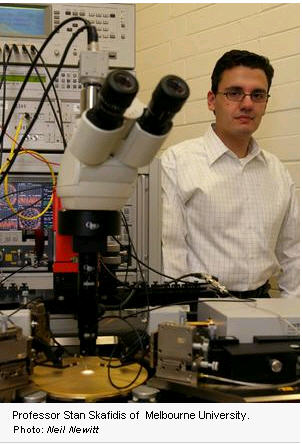New "GiFi" wireless chip unveiled: 5 gigs per second up to 10 meters!


I mean, wouldn't you be if today was the day you were formally announcing and demonstrating a chip that could transmit five gigabits per second of data over a wireless connection, for a distance of up to 10 meters (abour 32 feet)
The website of Melbourne, Australia's The Age newspaper has the story.
"An entire high-definition movie from a video shop kiosk could be transmitted to a mobile phone in a few seconds, and the phone could then upload the movie to a home computer or screen at the same speed," writes Nick Miller.
The chip's inventor is Melbourne University Prof. Stan Skafidis, who you are looking at, @ the top of this post.
His chip uses only a tiny one-millimeter-wide antenna and less than two watts of power, and would cost less than $10 to manufacture.
"It uses the 60GHz "millimetre wave" spectrum to transmit the data, which gives it an advantage over WiFi (wireless internet)," Nick writes. "WiFi's part of the spectrum is increasingly crowded, sharing the waves with devices such as cordless phones, which leads to interference and slower speeds. "But the millimetre wave spectrum (30 to 300 GHz) is almost unoccupied, and the new chip is potentially hundreds of times faster than the average home WiFi unit."
Cool? Check.
Promising? Check.
Ready for prime time? Or better yet, is prime time ready for it? Perhaps not just yet. I mean, I don't see the necessary imperatives in place yet that would forcibly inject the GiFi chip into devices.
But maybe in a couple of years?